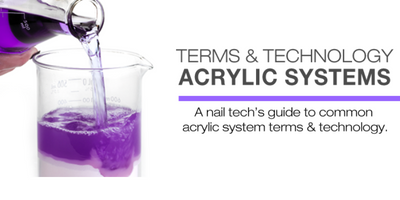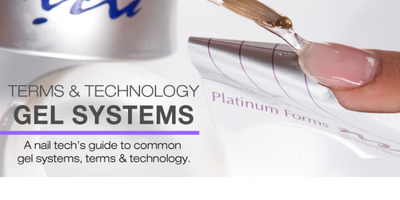TERMS & TECHNOLOGY: ACRYLIC SYSTEMS
A nail tech’s guide to common acrylic system terms & technology.

With the popularity of acrylic nails and acrylic products available on the market today, it’s important to know exactly what you are buying. As the demand for nail enhancements grow in salons today, they have moved from just a salon service, to a hot commodity. Acrylic nail systems have existed for years, and helped kickstart the industry, thus really put nail enhancements on the map.
THE HISTORY OF ACRYLIC NAILS
Nail enhancements have been used since the mid to late 1950s when the first experiments used dental products to form an artificial nail. Of course, in the beginning, acrylic nails weren’t so wonderful, as they are today.
IN FACT: NSI and specifically the Slack family, have been proven pioneers in product innovation and techniques. NSI has been at the forefront of creating innovative professional only enhancement products. Our first product branded was Choice Liquid & Powder System.
NOT ALL PRODUCTS ARE ALIKE
A popular myth is that all acrylic products are alike. Some manufacturers of less expensive items promote their acrylic products as the same as the more expensive brands. Nothing could be further from the truth.
Inexpensive products use basic formulas with a minimal amount of specialized ingredients. Special additives, such as flow modifiers, catalysts, and wetting agents increase performance and workability. They also can increase cost dramatically.
Online 3rd party retailers such as Amazon, Ebay and Alibaba are home to where a lot of these off brand products are sold and distributed. But don’t be fooled. There are also risks included in buying name brand products from these sites. A number of acrylic manufacturers, including NSI, discourage purchasing their products from these sites because of risk of product contamination, 2nd hand product, and even counterfeit products. A good practice for buying any nail product is to go to an authorized distributor or purchasing directly from the manufacturer.
TERMINOLOGY:
Monomer: The Merriam-Webster Dictionary defines monomer as “a simple chemical compound that can be polymerized.” In the nail industry, it is the term for nail liquid used when creating acrylic nails. There are different types of monomers and the most commonly used are EMA-based (ethyl methacrylate) monomers.
STAY AWAY FROM MMA NAIL LIQUID
The use of Methyl Methacrylate (MMA) (monomer un-polymerized liquid) is prohibited in the nail industry because it results in hard, polymerized solid plastic, which is considered too hard for nail systems. MMA monomer has been restricted for use in the nail industry since the mid 1970s. Although banned, this product is still being used in some non-standard salons because of its cost being significantly less than that of EMA-based monomers.
Polymer: The Merriam-Webster Dictionary defines polymer as “a chemical compound formed by union of small molecules and usually consisting of repeating structural units”. In the nail industry, this term is used for nail powder.
Light-Cured Acrylic: Similar to traditional acrylic nails, this two part system consists of nail liquid (monomer) with nail powder (polymer). The difference being that this product cures with a UV lamp. The set-up time for light-cured acrylic is much slower than traditional acrylic and the products can be quite difficult to work with.
Odor-Free Acrylic: This type of liquid evaporates very slowly, creating little vapor (hence, undetectable odor). It can be difficult to work with, and requires a dry mix ratio. Because Odor-Free liquids set up very slow, a specific technique to application is required. NSI Spa Nail Liquid is a great odor-free monomer that creates beautiful nail enhancements when used with the NSI acrylic nail powders.
HEMA-Free (Sensitive) Acrylic: Hydroxy Ethyl Methacrylate (HEMA) is added to many monomers to promote adhesion of the enhancement to the natural nail. Most of the allergic reactions are caused by the HEMA in nail enhancement products. Although HEMA is mostly found in monomer, gels do contain small amounts of HEMA as well. NSI does have a HEMA-Free nail liquid, Universal Nail Liquid, for clients that experience sensitivity issues.
Primerless Acrylic: With Primerless nail liquids, you can eliminate the use of a nail primer and still create strong, beautiful acrylic nails. A medium wet mix ratio is required. The consistency will be a creamier texture because of added HEMA, and will result in a slower cure time for great for art and adhesion. Secrets Primerless Liquid works beautifully with any NSI acrylic powder to create beautiful enhancements and nail art.
MYTHS:
Gels are better for the natural nails than acrylics.
This could not be further from the truth. Enhancement products do not damage nails, it is what nail technicians do in the application of enhancements, or clients improper home removal that damages the nail. It is the job of a professional nail technician to maintain the health of the clients’ nails.
Acrylic nail enhancements are stronger than gels.
No. This is not true! With any enhancement system, it is important to have a well balanced nail enhancement, this can be achieved with both acrylic nails and with gel nails, they are both tough.
I can use any company’s monomer with any polymer I buy.
This is not true. High quality acrylic systems are sold as just that, a system. These products have been formulated so that they all work together properly, and won’t always work when mixed with other product. When you begin to mix different products from different manufacturers you can end up with faster enhancement breakdown, improper mix ratios and many more potential problems.
Here at NSI, we have our own lab and scientists that work endlessly to produce high quality products that are then tested by nail techs around the world. NSI is a product driven company that will always continue to produce high quality products for their consumers around the world.


